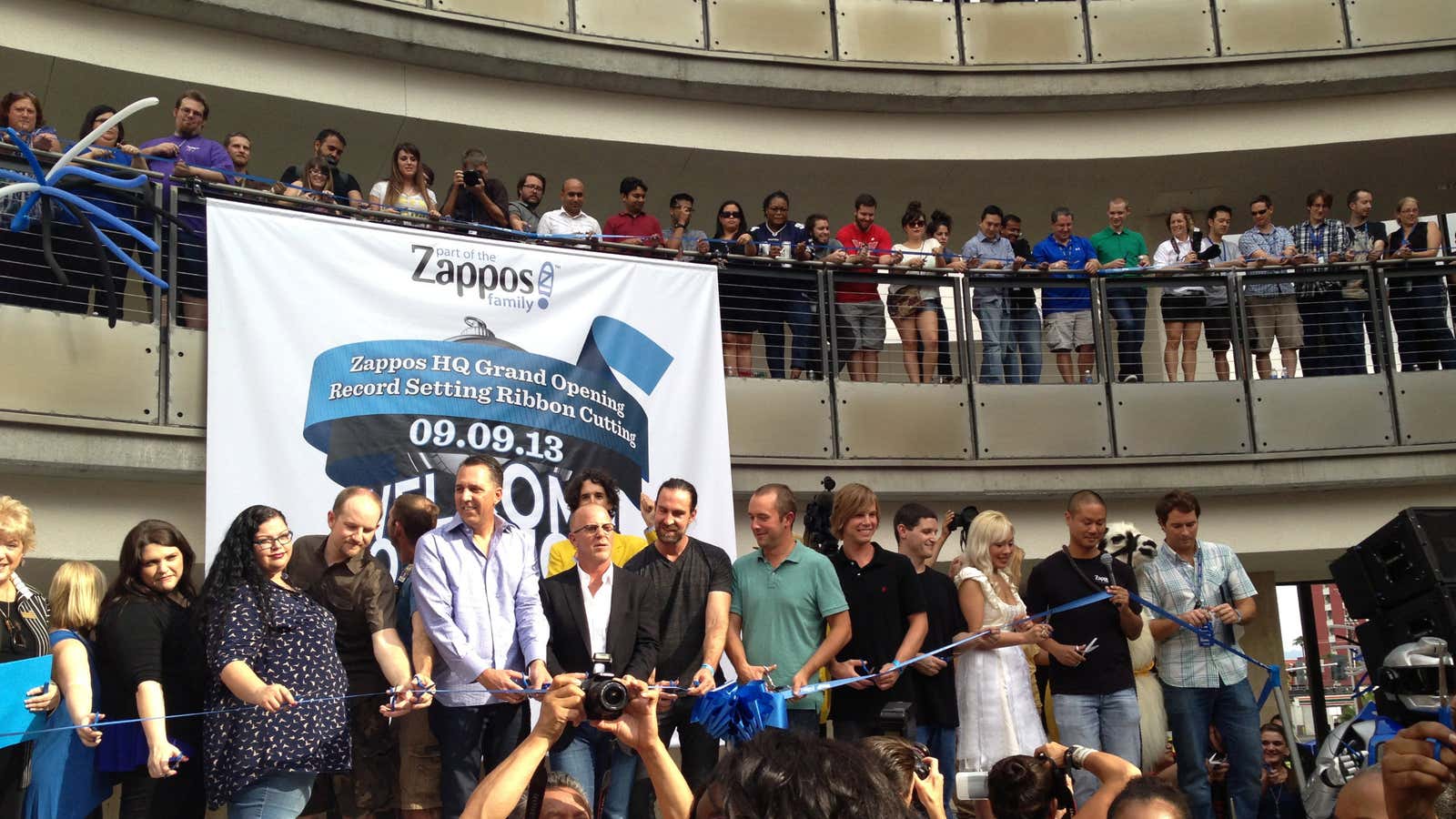Zappos is known for its zany corporate culture. The company’s Q4 “All Hands” meeting in November was aptly-themed “Gone Wild”: one female employee voluntarily climbed into a case filled with tarantulas to win a $250 gift card. The event opened with a Lion King performance put on by employees at the Smith Center in downtown Las Vegas and closed with an after party at the museum next door. Focusing on company culture and customer service is how CEO Tony Hsieh built Zappos into a billion-dollar online retailer. While he’s not getting rid of those priorities, Hsieh is laying the groundwork for a major reorganization.
During the 4-hour meeting, Hsieh talked about how Zappos’ traditional organizational structure is being replaced with Holacracy, a radical “self-governing” operating system where there are no job titles and no managers. The term Holacracy is derived from the Greek word holon, which means a whole that’s part of a greater whole. Instead of a top-down hierarchy, there’s a flatter “holarchy” that distributes power more evenly. The company will be made up of different circles—there will be around 400 circles at Zappos once the rollout is complete in December 2014—and employees can have any number of roles within those circles. This way, there’s no hiding under titles; radical transparency is the goal.
Hsieh told the crowd on that rainy November afternoon, “Darwin said that it’s not the fastest or strongest that survive. It’s the ones most adaptive to change.”
Last fall, while exploring ways to scale Zappos without letting bureaucracy set in, Hsieh met Brian Robertson, the founder of the management consultancy HolacracyOne.
“Zappos’ focus on core values and culture has done a remarkably good job of getting around the limits of a conventional corporate structure,” says Robertson, who created the company in 2007 after using Holacracy to run a software company that he founded. “Leaders that already understand the limits of conventional structures are the ones that are attracted to Holacracy.”
CEOs who sign on to Holacracy agree to cede some level of power. The advantage is that they get to view their company through an entirely different lens. But it’s an adjustment for both leaders and employees. Zappos, which has 1,500 employees, will be the largest company to date to implement Holacracy.
“We’re classically trained to think of ‘work’ in the traditional paradigm,” says John Bunch, who, along with Alexis Gonzales-Black, is leading the transition to Holacracy at Zappos. “One of the core principles is people taking personal accountability for their work. It’s not leaderless. There are certainly people who hold a bigger scope of purpose for the organization than others. What it does do is distribute leadership into each role. Everybody is expected to lead and be an entrepreneur in their own roles, and Holacracy empowers them to do so.”
In its highest-functioning form, he says, the system is “politics-free, quickly evolving to define and operate the purpose of the organization, responding to market and real-world conditions in real time. It’s creating a structure in which people have flexibility to pursue what they’re passionate about.”
Twitter Co-Founder Ev Williams is one of the system’s early adopters; he uses Holacracy to run his publishing platform Medium, which has around 50 employees. Jason Stirman, whose roles include head of people operations and product designer at Medium, says that one of the best things about Holacracy is that it facilitates autonomy. “Ev isn’t the CEO of Medium to have another title for his Twitter bio. He wants the company to operate at the highest level possible, and he recognizes that all the power consolidated at top is great for people who are hungry but it can be a total bottleneck. There are decisions he wants to make and the rest can be absorbed in other areas of the organization.”
Still, Holacracy can feel unnatural, especially at first. Meetings are designed to rapidly process tensions. The focus is on the work, not the people. “It’s not a very human-centric model for things,” says Stirman. “For example, if you’re a junior designer, Holacracy says that you should bring up everything in this forum, but it can be difficult to ask for feedback or mentorship, especially when you’re new.”
Robertson says that Holacracy is meant to address structural issues, and that leaders will respond to the human element in different ways. Medium has created mentorship circles, and Zappos has similar plans. Williams and Hsieh both “have a high capacity to see the complex systems at play in their organizations,” says Robertson. “It’s not linear or a matter of just following the logical argument; it’s seeing the cloud of interconnections and influences, beyond just cause and effect thinking.”
At the Zappos “All Hands” meeting Hsieh said that at most companies, “there’s the org chart on paper, and then the one that is exactly how the company operates for real, and then there’s the org chart that it would like to have in order to operate more efficiently. … [With Holacracy] the idea is to process tensions so that the three org charts are pretty close together.”
Hsieh’s plans for Zappos are part of an even more ambitious undertaking. He’s currently investing $350 million of his own fortune to transform downtown Las Vegas, where Zappos’ is now headquartered, into an improved holarchical system. For Hsieh, work, play and everything else are already a series of overlapping circles.
